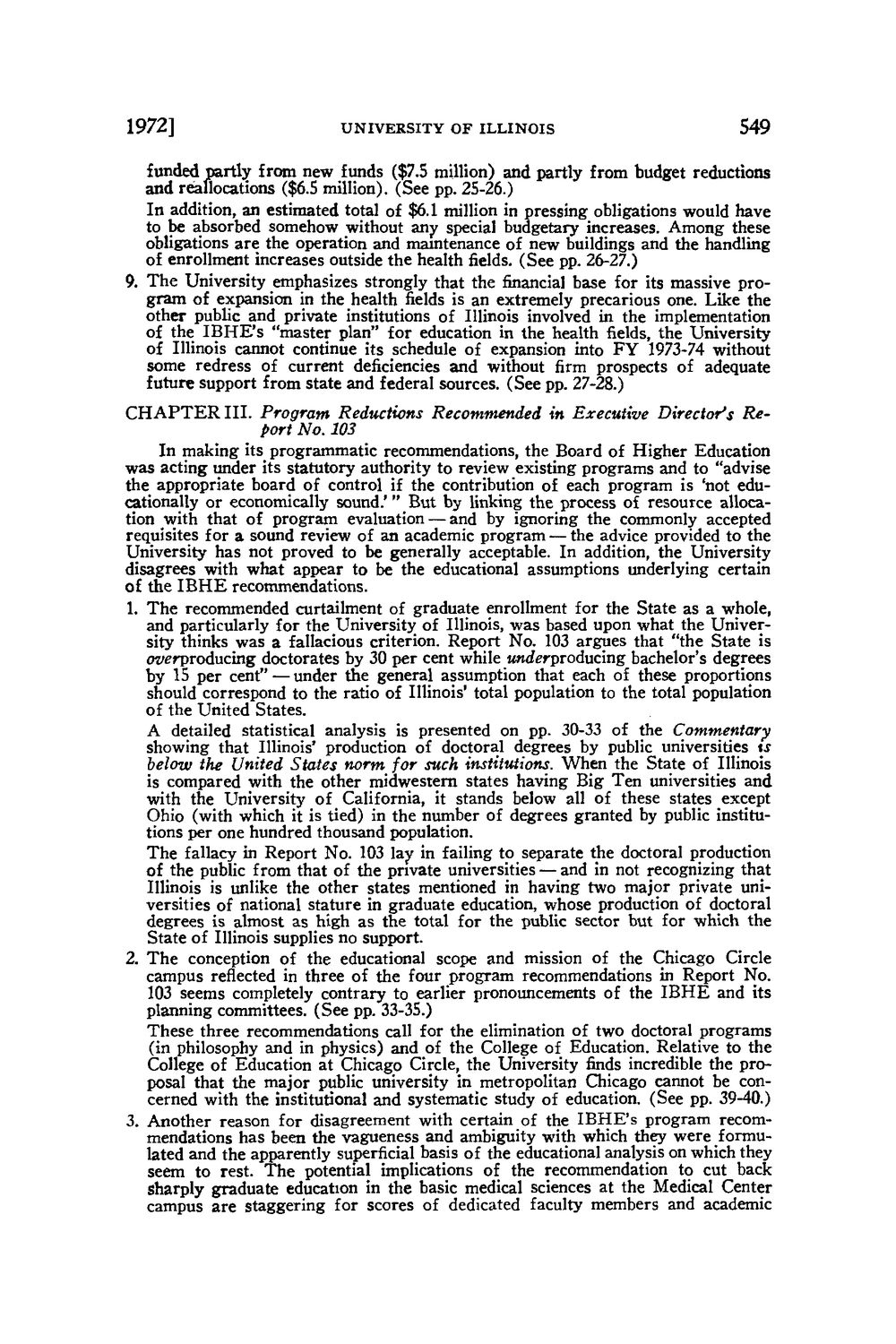| |
| |
Caption: Board of Trustees Minutes - 1972
This is a reduced-resolution page image for fast online browsing.

EXTRACTED TEXT FROM PAGE:
1972] UNIVERSITY OF ILLINOIS 549 funded partly from new funds ($7.5 million) and partly from budget reductions and reallocations ($6.5 million). (See pp. 25-26.) In addition, an estimated total of $6.1 million in pressing obligations would have to be absorbed somehow without any special budgetary increases. Among these obligations are the operation and maintenance of new buildings and the handling of enrollment increases outside the health fields. (See pp. 26-27.) 9. The University emphasizes strongly that the financial base for its massive program of expansion in the health fields is an extremely precarious one. Like the other public and private institutions of Illinois involved in the implementation of the IBHE's "master plan" for education in the health fields, the University of Illinois cannot continue its schedule of expansion into FY 1973-74 without some redress of current deficiencies and without firm prospects of adequate future support from state and federal sources. (See pp. 27-28.) CHAPTER III. Program Reductions Recommended in Executive Director's Report No. 103 In making its programmatic recommendations, the Board of Higher Education was acting under its statutory authority to review existing programs and to "advise the appropriate board of control if the contribution of each program is 'not educationally or economically sound.' " But by linking the process of resource allocation with that of program evaluation — and by ignoring the commonly accepted requisites for a sound review of an academic program — the advice provided to the University has not proved to be generally acceptable. In addition, the University disagrees with what appear to be the educational assumptions underlying certain of the IBHE recommendations. 1. The recommended curtailment of graduate enrollment for the State as a whole, and particularly for the University of Illinois, was based upon what the University thinks was a fallacious criterion. Report No. 103 argues that "the State is overproducing doctorates by 30 per cent while underproducing bachelor's degrees by 15 per cent" — under the general assumption that each of these proportions should correspond to the ratio of Illinois' total population to the total population of the United States. A detailed statistical analysis is presented on pp. 30-33 of the Commentary showing that Illinois' production of doctoral degrees by public universities \s below the United States norm for such institutions. When the State of Illinois is compared with the other midwestern states having Big Ten universities and with the University of California, it stands below all of these states except Ohio (with which it is tied) in the number of degrees granted by public institutions per one hundred thousand population. The fallacy in Report No. 103 lay in failing to separate the doctoral production of the public from that of the private universities — and in not recognizing that Illinois is unlike the other states mentioned in having two major private universities of national stature in graduate education, whose production of doctoral degrees is almost as high as the total for the public sector but for which the State of Illinois supplies no support. 2. The conception of the educational scope and mission of the Chicago Circle campus reflected in three of the four program recommendations in Report No. 103 seems completely contrary to earlier pronouncements of the IBHE and its planning committees. (See pp. 33-35.) These three recommendations call for the elimination of two doctoral programs (in philosophy and in physics) and of the College of Education. Relative to the College of Education at Chicago Circle, the University finds incredible the proposal that the major public university in metropolitan Chicago cannot be concerned with the institutional and systematic study of education. (See pp. 39-40.) 3. Another reason for disagreement with certain of the IBHE's program recommendations has been the vagueness and ambiguity with which they were formulated and the apparently superficial basis of the educational analysis on which they seem to rest. The potential implications of the recommendation to cut back sharply graduate education in the basic medical sciences at the Medical Center campus are staggering for scores of dedicated faculty members and academic
| |